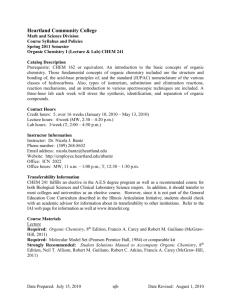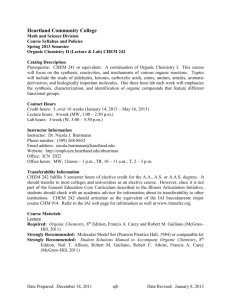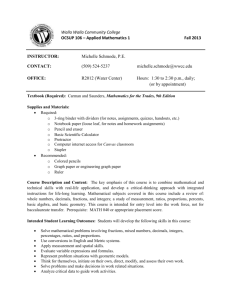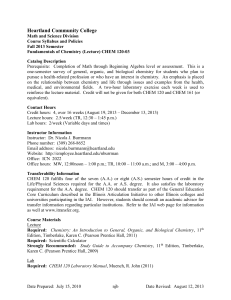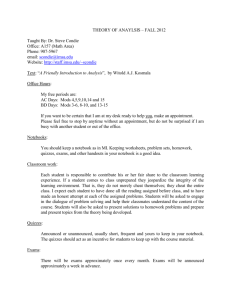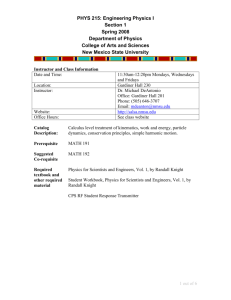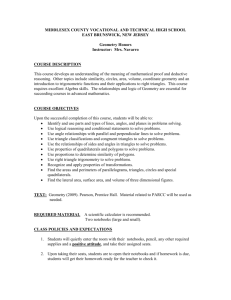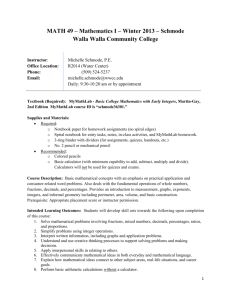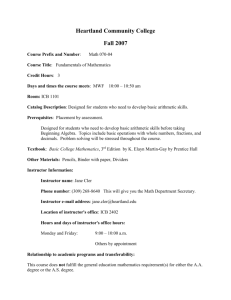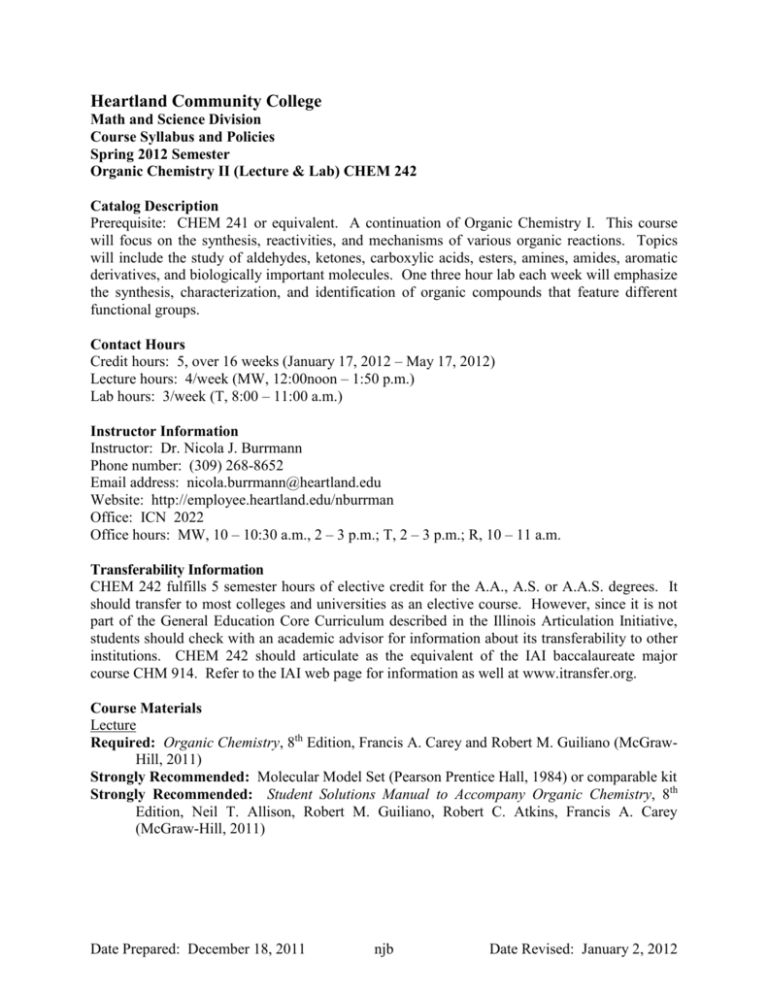
Heartland Community College
Math and Science Division
Course Syllabus and Policies
Spring 2012 Semester
Organic Chemistry II (Lecture & Lab) CHEM 242
Catalog Description
Prerequisite: CHEM 241 or equivalent. A continuation of Organic Chemistry I. This course
will focus on the synthesis, reactivities, and mechanisms of various organic reactions. Topics
will include the study of aldehydes, ketones, carboxylic acids, esters, amines, amides, aromatic
derivatives, and biologically important molecules. One three hour lab each week will emphasize
the synthesis, characterization, and identification of organic compounds that feature different
functional groups.
Contact Hours
Credit hours: 5, over 16 weeks (January 17, 2012 – May 17, 2012)
Lecture hours: 4/week (MW, 12:00noon – 1:50 p.m.)
Lab hours: 3/week (T, 8:00 – 11:00 a.m.)
Instructor Information
Instructor: Dr. Nicola J. Burrmann
Phone number: (309) 268-8652
Email address: nicola.burrmann@heartland.edu
Website: http://employee.heartland.edu/nburrman
Office: ICN 2022
Office hours: MW, 10 – 10:30 a.m., 2 – 3 p.m.; T, 2 – 3 p.m.; R, 10 – 11 a.m.
Transferability Information
CHEM 242 fulfills 5 semester hours of elective credit for the A.A., A.S. or A.A.S. degrees. It
should transfer to most colleges and universities as an elective course. However, since it is not
part of the General Education Core Curriculum described in the Illinois Articulation Initiative,
students should check with an academic advisor for information about its transferability to other
institutions. CHEM 242 should articulate as the equivalent of the IAI baccalaureate major
course CHM 914. Refer to the IAI web page for information as well at www.itransfer.org.
Course Materials
Lecture
Required: Organic Chemistry, 8th Edition, Francis A. Carey and Robert M. Guiliano (McGrawHill, 2011)
Strongly Recommended: Molecular Model Set (Pearson Prentice Hall, 1984) or comparable kit
Strongly Recommended: Student Solutions Manual to Accompany Organic Chemistry, 8th
Edition, Neil T. Allison, Robert M. Guiliano, Robert C. Atkins, Francis A. Carey
(McGraw-Hill, 2011)
Date Prepared: December 18, 2011
njb
Date Revised: January 2, 2012
Lab
Required: CHEM 242: Organic Chemistry II Lab Manual, Nicola J. Burrmann (2012) (Will
be distributed as handouts throughout the semester)
Required: Duplicating (e.g. carbon copy) lab notebook
Required: A scientific or graphing calculator
Required: Safety goggles or glasses (provided by HCC or supply your own)
Required Reading and Writing
This course will require approximately 600 pages of text from both the lecture and lab textbooks
over a 16-week period. Written analysis will be required in the form of problem sets, quizzes,
exams, and both formal and informal laboratory reports.
Course Description and Learning Objectives
This is the second course of a two-semester sequence intended for those students with an interest in
a science major, such as chemistry, chemical engineering, biology, or physics, or a preprofessional major, such as pre-medical, pre-dental, or pre-pharmacy. This course covers the
detailed mechanistic explanations of a variety of synthetic organic reactions, as well as the
prediction of reagents necessary to bring about a series of synthetic transformations. These skills
will ultimately be used in the planning of the total synthesis of a diverse group of organic
compounds.
By the end of this course, students will have developed an understanding of the fundamental
concepts of organic chemistry, as well as critical thinking and analysis skills. While learning and
understanding the core concepts of organic chemistry will be vital for success, emphasis on exams,
quizzes, and problem sets will be placed on critical thinking and problem solving abilities. This
means that while some questions on these assessments will be based directly from material presented
in class (PS1, PS2), many problems will ask you to use or interpret your knowledge in a new, related
way (PS3, PS4, CT1, CT2, CT3). This will be achieved by
-
applying concepts of stability and reactivity to conjugated and aromatic systems,
determining the chemical reactivity of aromatic molecules with both electrophiles and
nucleophiles,
understanding the oxidative and reductive reactivity of alcohols, aldehydes, ketones, and
carboxylic acids,
reviewing and expanding upon the reactivity of alcohols, ethers, and analogous sulfur-containing
compounds,
understanding the properties of a variety of carbonyl compounds, including aldehydes, ketones,
carboxylic acids, esters, anhydrides, and acyl halides,
determining the chemical reactivity of these classes of carbonyl compounds, involving wide
range of nucleophiles and electrophiles,
understanding the methods for preparing carbon-based nucleophiles, such as organolithium and
Grignard reagents, then reacting these nucleophiles with a variety of electrophiles,
understanding the methods for preparing and reacting enols and enolates,
understanding the properties and nucleophilic reactivity of amines, as well as their preparation
using reductive and substitution reactions, and
applying these reactions to biologically-relevant molecules, like carbohydrates and amino acids
Date Prepared: December 18, 2011
njb
Date Revised: January 2, 2012
The lab portion of this class will highlight concepts presented in lecture using practical techniques,
including characterization, synthesis, and purification of compounds. A large portion of report
grades will be based on effectively analyzing and defending results obtained in the laboratory (CO1,
CT1), through either informal or formal laboratory reports.
Method of Evaluation (Grading System)
Grades will be determined by a combination of problem sets, quizzes, exams, and lab work
("assessments"). Points will be distributed as follows:
Assessment
Number of Each
Assessment
6
5*
3
1
8
12
2
Lecture Problem Sets
Quizzes
Lecture Exams
Lecture Final Exam
Lab Reports
Lab Technique
Lab Exams
Total Points Possible
* Lowest quiz score will be dropped.
Points Possible (Each)
Total Points
25
25
100
200
Variable (See Schedule)
3
40
150
100
300
200
134
36
80
1000
Grades will be based on a set scale:
A: ≥ 85.0%
B: 75.0 – 84.9%
C: 65.0 – 74.9%
D: 60.0 – 64.9%
Incompletes will only be given in rare circumstances, approved by the course instructor.
Date Prepared: December 18, 2011
njb
Date Revised: January 2, 2012
Lecture Schedule
Week of
Chapter(s) Covered
January 16
10
January 23
10, 11
January 30
11
February 6
February 13
February 20
12
12, 22 (selected)
15
15, 16,
22 (remainder)
17
February 27
March 5
March 12
March 19
17, 14
March 26
April 2
April 16
April 23
April 30
May 7
14, 15 (selected)
18
18, 15 (remainder),
19
19
19, 20
20
21
May 14
None
April 9
PS, Quiz, or Exam?
No Class M (MLK Jr. Day)
Problem Set 1 Due (W)
Last Day to Drop with Refund (M)
Quiz 1 (W)
Problem Set 2 Due (W)
Exam 1 (M) (Chapters 10 – 12, 22)
Problem Set 3 Due (W)
Quiz 2 (W)
Spring Break (No Classes)
Midterm Grades Due Online (M)
Problem Set 4 Due (W)
Quiz 3 (M)
Exam 2 (M) (Chapters 14 – 17, 22)
Problem Set 5 Due (W)
Last Day to Withdraw (R)
Quiz 4 (W)
Quiz 5 (W)
Problem Set 6 Due (W)
Exam 3 (W) (Chapters 18 – 21)
Comprehensive Final Exam
(M, May 14; 12:00 noon – 1:50 p.m.)
Please note that this schedule is tentative and may change.
Attendance and Make-Up Policy
Attendance for the lecture portion of the course is strongly recommended, not required.
Attendance for the lab portion of the course is required.
Quizzes and lab work cannot be made up for any reason. If you miss a quiz, this will count as
your dropped quiz. If you miss lab work, you will lose your technique points for the day, and
you may obtain lab data from one of your peers to complete your lab report. Note that it is your
responsibility to obtain this data and that your lab report will be assessed a penalty of 20%.
Lecture and lab exams cannot be made up after their scheduled date, except under highly
extenuating circumstances, as approved by the course instructor. If you know well in advance
that you will miss an exam, talk to the course instructor to schedule to take your exam before the
scheduled date.
Please remember to either turn off or put your phone into silent mode before the start of each
lecture and lab, in order to minimize disruptions. The course instructor reserves the right to
dismiss repeat offenders from a class period after an interruption.
Date Prepared: December 18, 2011
njb
Date Revised: January 2, 2012
Lecture Homework, Problem Sets, Quizzes, and Exams
One full class period will be devoted to each exam. Quizzes will be given at the beginning of
class periods, with 30 – 45 minutes devoted to the quiz, depending on the content and difficulty
level. Use of molecular models on quizzes and tests is allowed and encouraged; however models
may not be shared between students during quizzes and tests.
Course exams and quizzes will consist of questions in a variety of formats, including (but not
limited to) multiple choice and free response. No partial credit will be given for multiple choice
questions. Partial credit will be given on the free response questions, so be as complete as
possible! Your lowest quiz score will be dropped at the end of the semester.
Selected homework problems assigned for each chapter in the textbook are completely optional.
No grades or point values will be assigned to homework problems. The content of these
questions will usually be highly reflective of the content included in quiz and exam questions.
Therefore, completing the supplemental homework is strongly recommended, as doing so will
give you an opportunity to demonstrate your mastery of topics presented in class.
Six problem sets will be given out during the semester, and these should be completed for course
credit. The textbook and internet are acceptable resources of information for these problem sets.
While working on these problem sets with a group of peers is strongly encouraged, be sure to
record all answers in your own words – Do not plagiarize! (Please see next section on Academic
Integrity and Plagiarism. Working together with peers means that you should work together,
step-by-step, until you arrive at an answer or work independently and then compare work at the
end. However, it is unacceptable to directly copy someone else's answer without understanding
why the answer is what it is and how it was derived.
Laboratory Information
The lab portion of this course will consist of ten experiments (with reports and technique
assessments), two problem sets, and two exams over a 16-week period. Each of the labs will be
related to the content presented in the lecture portion of the class. Lab grades will be determined
by a combination of lab reports, lab problem sets, technique, and exams. The point values of
each lab report, problem set, and exam are found in parentheses on the lab schedule.
Date Prepared: December 18, 2011
njb
Date Revised: January 2, 2012
Lab Schedule
Week of
Experiment
January 16
Lab Check-In and Policy Overview
January 23
None
January 30
Diels-Alder (8) †
February 6
EAS – Bromination (10) †
February 13
EAS – Friedel-Crafts Acylation, Part 1 (Acylation) (Report with Part 2) †
February 20
EAS – Friedel-Crafts Acylation, Part 2 (Distillation) (16) †
February 27
Oxidation (10) †
March 5
None; Lab Midterm Exam (40)
March 12
Spring Break (No Classes)
March 19
Reduction (Report with Acetal) †
March 26
Acetal (20) †
April 2
Grignard (10) †
April 9
Esterification – Synthesis of Aspirin (Report with Wintergreen) †
April 16
Esterification – Synthesis of Wintergreen (20) †
April 23
Aldol, Part 1 (Aldol) (Report with Part 2) †
April 30
Aldol, Part 2 (Recrystallization) (40) †
May 7
None; Lab Final Exam (40)
May 14
None (Final Exam Week)
† Technique points will be awarded
‡ Formal lab report
Lab Exams
Two lab exams will be given, as indicated on the lab schedule. These exams will cover
experimental concepts and techniques that have been used in lab prior to the date the exam is
given. Possible exam questions include, but are not limited to, calculating percent yields or other
information (as done in lab), identifying glassware or an entire experimental setup, or describing
a type of experiment that would be used to achieve a particular result.
Lab Reports
A written laboratory report (either formal or informal) will be required for each experiment
performed. Guidelines for the written laboratory reports are detailed below. Laboratory reports
are always due at the beginning of the next lab period, after all components of the experiment are
completed. Reports may be turned in one day late and will be assessed a 20% penalty. Reports
will not be accepted more than one day after they are due.
Keeping a Lab Notebook
Use either blue or black ink in your laboratory notebook. Use a single strikethrough to cross
things out – don’t scribble! It is very important to be neat and legible. If I cannot read your
handwriting, I cannot grade you effectively. Use a two-column format for writing out procedural
information. (See below for more information on writing procedures.)
Date Prepared: December 18, 2011
njb
Date Revised: January 2, 2012
Spelling and grammar do count. If a word is given to you in the laboratory manual, it should be
spelled correctly! Do not use abbreviations unless it is the chemical formula for a common
reagent; e.g. HCl for hydrochloric acid is fine. Set off sections (Reaction, Discussion, etc.) with
headers, preferably capitalized or underlined, so they’re easily distinguishable on the page.
Informal Lab Reports
Informal lab reports will consist of turning in the duplicate pages from your lab notebook, as
well as completed and analyzed spectral characterization data for the experiment. The
information in the following paragraphs should be recorded in your lab notebook. Be sure to
leave some space in the margins for instructor comments.
Before Lab
Read through the materials pertaining to the day’s topic and complete the “Pre-Lab” portion of
your notebook. (See below for more information on what should be included in your Pre-Lab.)
The Pre-Lab must be approved and initialed by the course instructor before beginning the
experiment. The following components should appear in a complete Pre-Lab:
-
-
-
Basic Information: Experiment title, your name and your partner’s name, and the date.
Purpose: Two to three sentences explaining why you are doing this experiment. The
purpose can include learning a new technique, completing a successful reaction, or achieving
a specific end-result. The purpose should be as specific as possible. Do not copy directly
from the lab text! This is plagiarism!
Reaction: A structural equation should be written for each reaction, if applicable. A
mechanism is not required.
Reagent Table: This should be done as a table. This should include the name of the reagents
being used (excluding solvents and those used for extractions or washing) and their
molecular weights, densities (for liquids), and/or melting or boiling points. You should also
include the amount of each reagent suggested in the lab manual, in grams or milliliters, as
well as moles or millimoles. (After your experiment is complete, you should go back and
add in the amounts of each reagent that you actually used.) Physical data (densities, etc.) can
be found at http://www.sigmaaldrich.com or a variety of other places on the internet.
Remember to site all sources! As a general rule of thumb, if the reaction cannot occur
without the use of a specific chemical, the chemical should be included in the reagent table.
In other words, no substitution for the chemical can be made and still have the reaction
occur.
Pre-Lab Questions: Write out the answers to the pre-lab questions that can be found in the
manual or provided by the course instructor, if there are any.
Procedural Outline: Write out an outline of the procedure for the experiment, using the lefthand column in your lab notebook. This procedure should include procedural steps and
amounts of chemicals. Write down what you will be doing (Use an oil bath to heat the flast),
how much chemical you will use (Add 25 mL of hexane, followed by 1.7 g Mg shavings,
etc.). Draw or refer to diagrams of your set-up. Do not just copy the procedure given to you!
I should be able to replicate your results based on this section of your report!
Date Prepared: December 18, 2011
njb
Date Revised: January 2, 2012
During Lab
- The course instructor will give a brief explanation of any new content, as well as an overview
of what to expect during the experiment.
- The experiment for the day should then be completed in its entirety, or to the point specified
by the course instructor. When working through the procedure, be sure to record any
procedural changes, data, and observations in the right-hand column of your lab notebook,
opposite to the relevant procedural point in the left-hand column. (With the example above:
25.4 mL hexane, 1.746 g Mg; solution turned yellow and cloudy, etc.) Make sure to include
all observations!
- Do not write data, etc. in other notebooks, in the lab manual, or anywhere other than in your
lab notebook!
- Technique: The course instructor will be observing you in lab and assessing your safety,
neatness, ability to follow instructions, and improvement in the laboratory. Up to five
technique points will be awarded for each lab period. Points will be deducted at the
instructor's discretion for using improper laboratory technique.
After Lab
- Perform all necessary calculations. Be sure to show work to receive partial credit, in case
your data was incorrect. Write out all of the steps for a calculation that needs to be done.
Label the calculations for what they are (percent yield, etc.) and be neat. If the course
instructor cannot determine what all numbers pertain to, credit will not be given.
- Analyze any spectra obtained for characterization purposes. Clearly label relevant portions
of the spectra and provide a brief explanation of what this data indicates for the relevant
compound. Draw the structure of your target molecule and assign peaks to structural
elements, if applicable. This must all be done directly on the spectra!
- Write an Error Analysis. Describe what went wrong, if anything, during the experiment.
Explain why percent yields or purities were low, or other recorded data does not match
expected values (if applicable). Don’t make things up as to what you think happened. If
some of the product mixture spilled, say so. Don’t say that something “could have
happened” and therefore “the results weren’t as good as they could have been.” Do not
repeat procedural details here, unless they specifically impacted your results or to explain
why a certain step was done.
- Write out the answers to any post-lab questions that can be found in the manual or provided
by the course instructor, if there are any.
Formal Lab Reports
For one experiment, a formal lab report will be written. This report must be typed and doublespaced, with one inch margins on all sides. You should use 12-point, Times New Roman font
and paragraph form. Write in past tense (since the experiment has already been completed), and
spelling and grammar do count. These formal reports will have identical components as listed
above for the "Before Lab" and "During Lab" sections, which do not need to be typed. Turn in
the duplicate pages from your lab notebook for these sections. For the "After Lab" portion of the
report, which should be typed, include:
Date Prepared: December 18, 2011
njb
Date Revised: January 2, 2012
-
-
-
-
Title Page: Include your name, a title for the experiment, the course number, and the date on
which the report is due.
Introduction: This section should develop the theory behind the experiment, including the
reaction that is being performed and why it is important. Discuss the unique aspects of the
experiment. A mechanism should be included in this section. Any idea that is not expressly
your own should be referenced. (See “References” below on how to do this.)
Results: This section summarizes the results obtained from the experiment. Perform all
necessary calculations, showing work, in your lab notebook, and summarize the final data in
a table within the formal report. Analyze any spectra obtained for characterization purposes,
as described above, and attach at the end of the report. Do not discuss what your results
mean in this section. Simply state them in an organized manner.
Discussion: This section is used to discuss what the experimental results mean and to show
understanding of the purpose for the experiment and the results obtained. Discuss why the
results turned out the way they did. Determine how accurate your data is by comparing
experimental values to theoretical values. Make sure to reference where you obtained your
theoretical values from. (See “References” below on how to do this.) Include the Error
Analysis for the experiment here.
Post-Lab: Type out the answers to any post-lab questions that can be found in the manual or
provided by the course instructor, if there are any, using paragraph form.
References: References are important for giving credit to data or ideas that are not your own.
Within the paper itself, use a superscript to denote a reference. At the end of your report,
insert a line or other indicator to show that the report itself is complete. Then reference the
work (according to ACS format) as follows:
(Within the introduction section…)
Thin-layer chromatography is a useful technique for following the progress of reactions.1
(Or within a discussion section…)
The observed melting point range of the unknown neutral compound in Unknown B was
67-71°C, which agrees closely with the theoretical melting point range of biphenyl, 68-70°C.2
(After your conclusion…)
1
2
Calimente, D.S.; Strand, S.M.; Chang, S.C; Lewis, D.E. J. Chem. Ed. 1999, 76, 82.
Sigma-Aldrich, http://www.sigmaaldrich.com/catalog/search/ProductDetail/RIEDEL/35800.
Date Prepared: December 18, 2011
njb
Date Revised: January 2, 2012
Academic Integrity and Plagiarism
All work submitted for grading should be solely your own. While working on homework with a
group of peers or using a variety of resources (textbook, peers, internet) for studying or lab work
is strongly encouraged, plagiarizing information will not be tolerated. Plagiarism is defined as
taking another person's ideas or work and presenting them as your own. This can include
copying or paraphrasing text from another source, whether it be printed (textbook or internet) or
verbal (peer). If other sources are used in the completion of your lab assignments (physical data,
pre- or post-lab questions), cite your sources with a textbook title and page number or website
address.
Plagiarism is considered a serious academic offense and violates the fundamental principle of
academic integrity. Heartland Community College allows for a variety of disciplinary responses
to plagiarism or other examples of academic misconduct, including course failure, suspension, or
expulsion from the College. Examples of academic misconduct can include, but are not limited
to, plagiarism, cheating, falsification or misrepresentation of data or academic records, and
assisting others in acts of academic misconduct. Further examples and definitions for academic
misconduct violations can be found in the college catalog.
The penalty for cheating on any course exam will be dismissal from the course with a failing
grade (F). A letter may also be placed in the student's permanent file at Heartland Community
College, at the discretion of the course instructor. Note that these decisions can be appealed
based on the appeals process found in the Heartland Community College Student Handbook.
Tips for Success
Study regularly and often, ideally every day. A large amount of material will be presented, and
the difficulty of these concepts will vary. Reading the corresponding sections of the textbook
and completing supplementary problems should greatly improve understanding of the material
discussed in class.
Do not "cram" right before a quiz or exam! Cramming will only allow very minimal amounts of
memorized information to be stored into your memory. As a majority of the quiz and exam
content will be based on giving free response explanations or extensions of material presented in
class, it is highly important that you learn not only the information itself, but also what it means
and how it's useful.
When working through suggested homework problems, do not look at the solutions until you
have worked through the problem to the best of your ability and written down an answer. It's
extremely easy to read a problem, immediately look at the answer, and think "That makes sense."
Taking the time to work through the problems and write down answers will serve as superior
learning tools to show how much of the course content is truly understood.
It is strongly recommended that you purchase and use a model kit while reading through the
textbook and working on homework and problem sets. It can be difficult to visualize twodimensional pictures of models as three-dimensional objects; however, this ability to visualize is
very important to determine molecular structure and, ultimately, reactivity. Model kits may also
be used on quizzes and exams.
Date Prepared: December 18, 2011
njb
Date Revised: January 2, 2012
Take advantage of the support services offered at Heartland Community College, such as the
library, tutoring center, and testing center:
-
The Library, located in the Student Commons Buildings at the Raab Road campus, provides
Heartland students with a full range of resources including books, online journal databases,
videos, newspapers, periodicals, reserves, and interlibrary loan. Librarians are available to
assist in locating information. For more information, please call the Library at (309) 2688200 or (309) 268-8292
-
Heartland Community College offers tutoring in various forms at no cost to Heartland
students at the Tutoring and Testing Center in Normal and at the Pontiac and Lincoln
Centers. Tutors are available at convenient times throughout the week. Study groups are also
available by request. For more information about services available at each location, please
call the Tutoring and Testing Center in Normal (309) at 268-8231, the Pontiac Center at
(815) 842-6777, or the Lincoln Center at (217) 735-1731.
-
The Tutoring and Testing Center provides a secure testing environment for students who are
enrolled in online, hybrid, and other distance learning courses; have a documented disability;
or need to take a make-up exam. Testing accommodations for students having documented
disabilities must be arranged by the student through the Office of Disability Services, and
Testing Services will only administer make-up exams at the request of the instructor.
Contact Testing Services at (309) 268-8050 for more information.
-
The Open Computing Lab provides free computing for HCC students at convenient times
throughout the week. The computer lab is staffed by trained Lab Assistants and offers the
use of approximately 70 computers, a scanner, a laser printer, and an electric typewriter.
-
Heartland Community College offers Disability Support Services (DSS) with offices located
in the Academic Support Center. DSS ensures that students with disabilities have equal
access to the college’s programs, services and activities through the provision of reasonable
accommodations as outlined in Section 504 of the Rehabilitation Act and the Americans with
Disabilities Act. DSS offers a wide range of services to support students with disabilities,
including assistive technology, document conversion services, personnel, classroom and
testing accommodations. Students with a documented disability who wish to discuss
academic accommodations can contact disability support services at (309) 268-8259.
Date Prepared: December 18, 2011
njb
Date Revised: January 2, 2012


